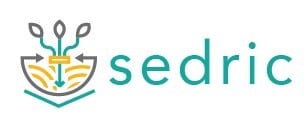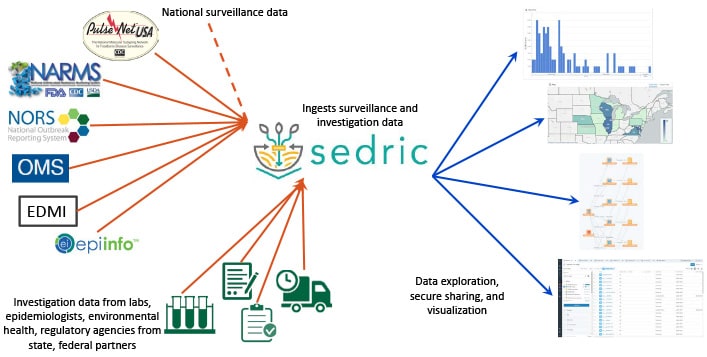Purpose
This page provides resources for public health investigators to learn more about using SEDRIC when investigating outbreaks.

On this page
What is SEDRIC?
Download the print or presentation version.
- The System for Enteric Disease Response, Investigation, and Coordination
- Web-based platform (in the cloud) developed by CDC and Palantir Technologies
- Facilitates collaborative multistate outbreak investigations of enteric disease
- Web-based platform (in the cloud) developed by CDC and Palantir Technologies
- SEDRIC is a customized, off-the-shelf web-based software system with four major capabilities
- Integrate multiple surveillance data sources in real time
- Visualize outbreak data rapidly in one place
- Provide a secure platform for partner collaboration
- Manage a repository of historic surveillance and outbreak data
- Integrate multiple surveillance data sources in real time
Who uses SEDRIC?
- SEDRIC facilitates secure electronic data-sharing among partners during outbreak investigations
- Partners currently using SEDRIC are epidemiologists, laboratorians, and regulators from
- State and local health departments
- CDC
- FDA
- USDA-FSIS, USDA-APHIS
- State and local health departments
How does SEDRIC work?
- CDC partners have access to SEDRIC for free
- Data Visualizations
- Manage and visualize clusters under investigation
- Visualize trends in time and space
- Visualize relationships
- Manage and visualize clusters under investigation
- Data Management
- Secure data sharing across agencies in real-time
- Data exploration
- Integration of future data sources
- Secure data sharing across agencies in real-time
How does this happen?
SEDRIC ingests surveillance data from PulseNet, NARMS, NORS, OMS, EDMI, and Epi Info as well as investigation data from epidemiologists, environmental health, regulatory agencies from state, federal partners. SEDRIC then compiles this information for data exploration, secure sharing, and visualization.


Highlights and limitations
- Highlights
- Intuitive GUI design, easy to learn
- No software to download, entirely web-based
- Surveillance data available in almost real-time
- Multiple surveillance sources available under a single platform (and more being added!)
- Fast (and pretty!) graphics
- Secure, real-time data sharing
- Intuitive GUI design, easy to learn
- Limitations
- Not an analytical platform
- Uni-directional data flow
- Not an analytical platform
Important web links
- https://sedric.cdc.gov
- https://www.cdc.gov/foodsafety/outbreaks/tools/sedric.html
- Information about SEDRIC
- Library of Training Documents
- Link to login
- Information about SEDRIC
10-year experience
- Increased speed and efficiency in cluster management and triage
- Easy, ad-hoc queries at our fingertips
- Search across surveillance sources
- Meeting times more effectively utilized
- Increased efficiency in creating summaries and visualizations for meetings, presentations, publications
- Easy, ad-hoc queries at our fingertips
- Empowering state and local epidemiologists, laboratorians, and food safety staff to easily mine and visualize their own surveillance data
- Collaboration!
